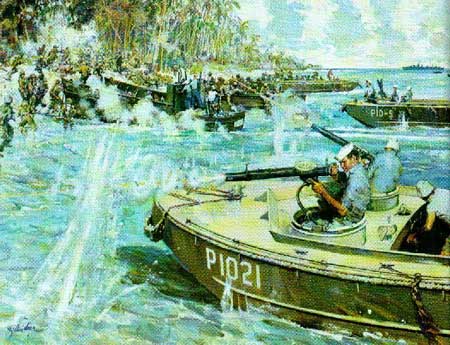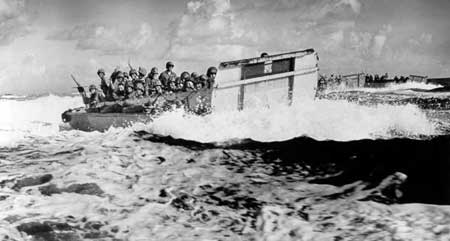| The War in the Pacific |
|
|
On Sept. 27, 1942, a group of diminutive landing craft sped toward the beaches of Guadalcanal. Huddled on shore, and fighting for their lives, were about 500 men of COL Lewis B. "Chesty" Puller's 1st Battalion, 7th Marines. Earlier that day, the same group of landing craft had put the Marines on the beach; now they were returning to extract them. As the LCVPs (Landing Craft, Vehicle, Personnel) and LCMs (Landing Craft, Mechanized) reached the shore, Coast Guard Signalman 1st Class Douglas Munro steered his LCVP between the evacuating Marines and the Japanese. By interposing his craft between the men on the beach and the enemy, Munro allowed the landing craft to safely evacuate all the Marines, including the wounded. As the last men climbed aboard, Munro steered his craft away from the beach. When almost clear, Japanese gunfire struck Munro and killed him instantly. Munro was posthumously awarded the Medal of Honor. It is fitting that given the Coast Guard's lifesaving tradition and the tremendous part the Coast Guard played during World War II, the Coast Guard's only Medal of Honor winner was not only involved with a rescue but also an amphibious operation. The Coast Guard's participation in amphibious activity during World War II was perhaps the most important war-related job the service performed. Incredibly, the Coast Guard fully manned more than 350 naval ships, including 76 LSTs (Landing Ship, Tank), 21 cargo and attack-cargo ships, 75 frigates, and 31 transports. In addition, the Coast Guard manned more than 800 cutters, nearly 300 ships for the Army, and thousands of amphibious-type assault craft. In the ships and craft of the amphibious forces, the Coast Guard discharged its most important role during the war - that is getting the men to the beaches and providing support. The largest Coast Guard-manned ships were the transports, and they played a vital role in landing operations. Just as vital, and generally overlooked, was the absolutely critical small-craft operations. The LCVPs, LCMs, Higgins Boats, LVTs (Landing Vehicle, Tracked) and others carried assault troops from the offshore transports and brought in reinforcements and supplies. The handling of these small craft in the surf is a specialized skill, and it was not common among men in the Navy. Not so for men in the Coast Guard. Many of the coxswains had learned this skill from handling boats in the surf at lifesaving stations. In fact, Coast Guard coxswains from lifesaving stations were the most seasoned smallboat handlers in government service. As only experienced men could successfully maneuver landing craft through strong currents, reefs, sand bars and heavy surf, their contributions to amphibious operations is immeasurable.
This experience was particularly important during the training exercises before the early amphibious operations. The Coast Guard's surfmen acted as mentors to the Navy coxswains trying to learn the nuances of controlling smallboats in the surf. During the early part of the war several thousand Coast Guard and Navy men were trained to handle landing craft. |

